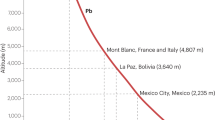Abstract
A series of pathological, physiological, and biochemical changes, even anatomical histological changes happen while humans arrive at the high plateau region from plain area. There is a certain relationship between the body’s compensatory or decompensated adjustments to the environment and the changes of absorption, distribution, metabolism, and excretion of drugs. The objective of the study is to observe the effects of acute exposure to high altitude at 4,010 m on pharmacokinetics of propranolol in rats, and to provide basis and new ideas to adjust drug dosage and administration, so as to promote rational drug use in high altitude. 28 healthy male wistar rats were randomly divided into four groups, group A and B which were in plain area; group C and D which were acutely exposed to high altitude by aviation; group A and C were used for pharmacokinetics determination of propranolol, while group B and D had no drug administration for physiological and pathological changes research at high altitude. The pharmacokinetics of propranolol significantly changed; area under curve, C max (the peak concentration), mean residence time, and t 1/2 (the biological half-life) increased significantly by 481.72, 398.94, 44.87, and 58.77 %, respectively; clearance and V (apparent volume of distribution) decreased by 81.50 and 70.56 %, respectively, after acute exposure to high altitude at 4,010 m; Analytic results show that pH, buffer base, base excess, ctCO2 (content of total carbon dioxide), sO2 (oxygen saturation of arterial blood), pO2 (oxygen tension of arterial blood), and cNa+ severely decreased by 2.43, 630.00, 311.00, 11.48, 91.38, 76.22, and 2.82 %, respectively, while pCO2 (carbon dioxide tension of arterial blood) and cCl− significantly increased by 47.40 and 6.76 %. Lactate dehydrogenase and total protein significantly decreased by 58.44 and 26.82 %, while total bilirubin and alkaline phosphatase severely increased by 338 and 24.94 % after acute exposure to high altitude at 4,010 m. Pathological research shows that alveolar wall is hyperemic, edematous, and incrassate; alveolus epithelium becomes hyperplastic while neutrophilic granulocytes infiltrate; brain neurons are edematous and perivascular space occurred; neurons of seahorse are metamorphic and karyopyknotic; mesangial cells are hyperplastic in kidney glomerulus tissue. We should reduce the dosage or extend the dosing interval in high altitude to maintain the drug concentration in therapeutic window since velocity of metabolism and excretion are reduced.






Similar content being viewed by others
References
Arancibia, A., Gai, M. N., Paulos, C., Chavez, J., & Pinilla, E. (2004). Effects of high altitude exposure on the pharmacokinetics of fursemide in healthy volunteers. International Journal of Clinical Pharmacology and Therapeutics, 42(6), 314–320.
Arancibia, A., Gai, M. N., Chavez, J., Paulos, C., Pinilla, E., Gonzalez, C., et al. (2005). Pharmacokinetics of prednisolone in man during acute and chronic exposure to high altitude. International Journal of Clinical Pharmacology and Therapeutics, 43(2), 85–91.
Asdaq, S. M., & Inamdar, M. N. (2011). Pharmacodynamic and pharmacokinetic interactions of propranolol with garlic (Allium sativum) in rats. Evidence-Based Complementary and Alternative Medicine, 2011, 824042.
Chow, M., & Tomlinson, B. (2006). A new sublingual formulation of propranolol for rapid absorption. In The fifteenth international pharmacology conferences (p. 216). Beijing, China.
Donovan, L., Welford, S. M., Haaga, J., LaManna, J., & Strohl, K. P. (2010). Hypoxia—Implications for pharmaceutical developments. Sleep and Breathing, 14(4), 291–298.
Fiore, D. C., Hall, S., & Shoja, P. (2010). Altitude illness: Risk factors, prevention, presentation, and treatment. American Family Physician, 82(9), 1103–1110.
Fradette, C., Shirley, J. L. B., & du Souich, P. (2007). Animal model of acute moderate hypoxia are associated with a down-regulation of CYP1A1, 1A2, 2B4, 2C5, and 2C16 and up-regulation of CYP3A6 and p-glycoprotein in liver. Drug Metabolism and Disposition, 5(35), 765–771.
Jun, F., Jun, Q., & Chun-xia, L. (2010). Establishment of normal reference range of blood hematological and biochemical indicators of SPF wistar rats. Journal of Public Health and Preventive Medicine, 6(21), 50–52.
Komura, H., & Iwaki, M. (2005). Pharmacokinetics and metabolism of metoprolol and propranolol in the female DA and female wistar rat: The female DA rat is not always an animal model for poor metabolizers of CYP2D6. Journal of Pharmaceutical Sciences, 94(2), 397–408.
Lee, E. J., Woodske, M. E., Zou, B., & O’Donnell, C. P. (2009). Dynamic arterial blood gas analysis in conscious, unrestrained C57BL/6J mice during exposure to intermittent hypoxia. Journal of Applied Physiology, 107(1), 290–294.
Mahutte, K. C. (1998). On-line arterial blood gas analysis with optodes: Current status. Clinical Biochemistry, 31(3), 119–130.
Walle, T., Fagan, T. C., Walle, U. K., Oexmann, M. J., Conradi, E. C., & Gaffney, T. E. (1981). Food-induced increase in propranolol bioavailability—relationship to protein and effects on metabolites. Clinical Pharmacology and Therapeutics, 30(6), 790–795.
Roberts, M. S., Wu, Z., & Weiss, M. (2000). Kinetics of propranolol uptake in muscle, skin, and fat of the isolated perfused rat hindlimb. European Journal of Pharmaceutical Sciences, 11(2), 165–172.
Venkatesh, B., & Boots, R. J. (1997). Carbon dioxide and oxygen partial pressure measurements in the cerebrospinal fluid in a conventional blood gas analyzer: Analysis of bias and precision. Journal of Neurological Sciences, 147, 5–8.
Wang, Y., Zuo, Z., Chen, X., Tomlinson, B., & Chow, M. S. (2010). Improving sublingual delivery of weak base compounds using pH(max) concept: Application to propranolol. European Journal of Pharmaceutical Sciences, 39(4), 272–278.
Yamaji, R., Sakamoto, M., & Miyatake, K. (1996). Hypoxia inhibits gastric emptying and gastric acid secretion in conscious rats. Journal of Nutrition, 2(126), 673.
Acknowledgments
The authors want to express their sincere thanks to the Department of Pharmacy of The Second Military Medical University and Maqu Shouqu yaoyuan development CO., LTD. Thanks for their support and housing at the investigation site to facilitate this study. Special thanks to Dr. Zhou, Teacher Cao, and Manager Zaxi for the technical assistance in our research.
Author information
Authors and Affiliations
Corresponding author
Rights and permissions
About this article
Cite this article
Wenbin, L., Rong, W., Hua, X. et al. Effects on Pharmacokinetics of Propranolol and Other Factors in Rats After Acute Exposure to High Altitude at 4,010 m. Cell Biochem Biophys 72, 27–36 (2015). https://doi.org/10.1007/s12013-014-0397-3
Published:
Issue Date:
DOI: https://doi.org/10.1007/s12013-014-0397-3



